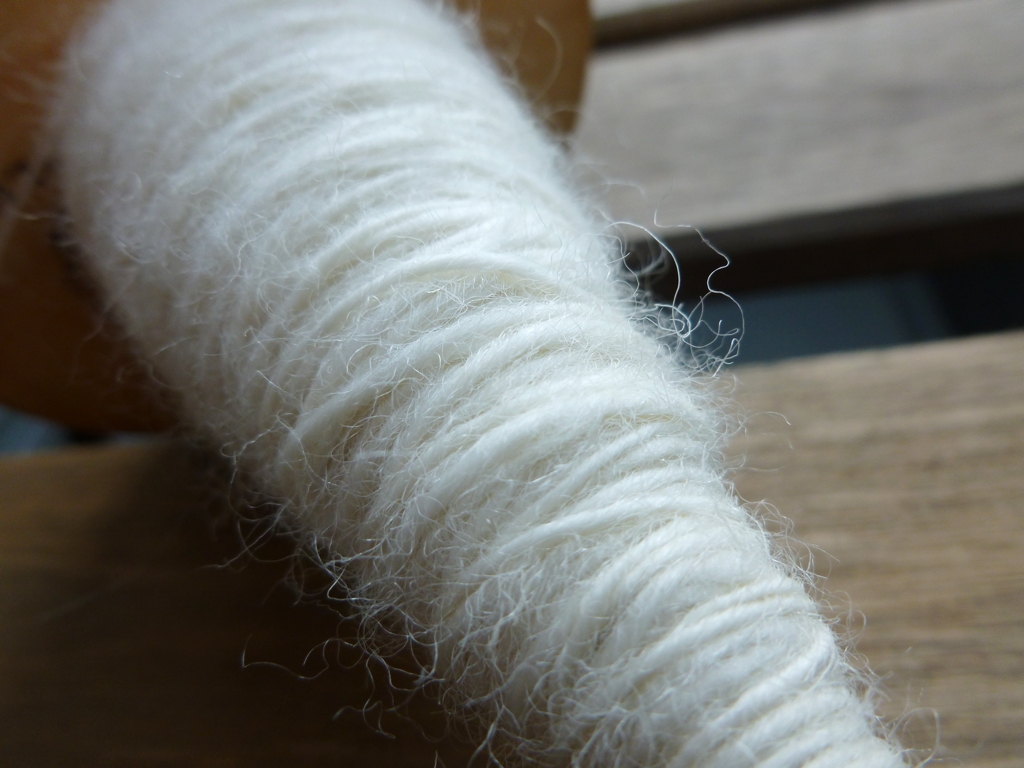Now I’m Really Finished With Tour de Fleece
/My spinning wheel and I spent a lot of time together last week as I finished plying my Tour de Fleece yarn. Glad I did too because, not only did I free up all my bobbins, I added some lovely new yarn to my stash. This Tour de Fleece handspun has really taken the edge off going Cold Sheep last month. 23 days and counting…
After the plying, it was time to set the twist for every skein. All the yarn got the same treatment. First, a 15+ minute soak in cool water with Eucalan. Second, squeezing out as much water by hand as possible and snapping the skeins over my forearms. Third, wrapping the yarn in a towel and squishing out even more water. Next time I’ll snap the yarns after the towel step because I was uniformly damp after finishing 9 skeins. I skipped thwacking them against the wall this time to keep a smooth surface. The last step was hanging them up to dry. The wait is usually the hardest part of the whole process, but washing before bed meant the yarn was dry and squish-able when I woke up the next day.
What started as 5 oz of BFL from Greenwood Fiberworks turned into ~500 yards of sport weight yarn. I put a lot of Z twist into these singles and plied them with S twist to match. Fresh off the bobbins, all 5 skeins were closer to fingering weight. Soaking during finishing gave them a good plump body that I can’t wait to use for a hat.
The 2-ply grey and mini batt yarn changed too. It bulked up to about 8 WPI and is firmly in the aran - bulky range after finishing. There are a few thick and thin in spots but those only add to its charm. Before going into the water, this yarn could have been described as lustrous. Washing the yarn relaxed the wool and gave the yarn a more rustic matte surface. All the glorious, out-of-my-comfort-zone color is still there though.
It’s been years since I’ve worried about screwing up my spinning. When you spin without an end project in mind, you get awesome yarn no matter how you spin. The other Tour de Fleece yarns only had loose goals attached to them - they’d a success no matter how they turned out. These two skeins of sock yarn were different. They needed to match, have stripes, be fingering weight, and have at least 500 yards between them. The skeins do match and I’ll probably see some mottled stripes when I start knitting. Instead of 500+ yards of opposing ply fingering weight, I’ve got about 330 yards of sport weight. I really need to start sampling before spinning half a pound of fiber. Live and learn.
I can accept those differences and still make the knitting work. What I was really worried about was mucking up the plying. It was so hard to evenly tension the yarn because of the opposing ply. I wasn’t sure if the yarn had too much twist or too little. I couldn’t tell if the S twist ply was joining well with the 2 Z twisted plies. Setting the twist was the only way to know for sure.
I was definitely relieved when I got my hands on the dry yarn. Both skeins are still kinked up with twist, but much less after going in the water. All the plies seem to be working well together too. Still, these skeins definitely weren’t my best attempt at plying, nor did they meet all my goals. I can still knit with the yarn though which counts as a successful spin to me.
Frustration aside, I’m happy with everything that I spun during Tour de Fleece and the next week. All the yarn is beautiful and oh so tempting. There is, however, one difference between this Tour de Fleece and previous years. I have plans and projects for everything I’ve spun. The ombre bundle is going to be a stocking hat. The colorful, bulky 2-ply is going to be a Myndie shawl. The sock yarn is going to be socks of course. Feels good to have a plan for this 1000+ yards that I’ve spun. Also feels pretty good to know that I can spin that much in a month when I want to. Now I’m off to knit and start my next spinning project.



























